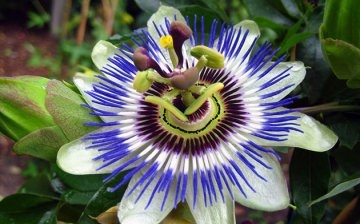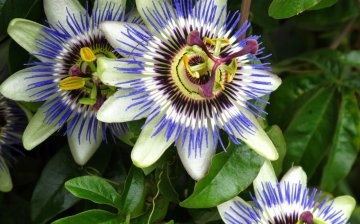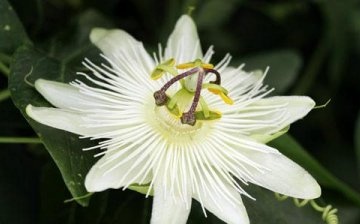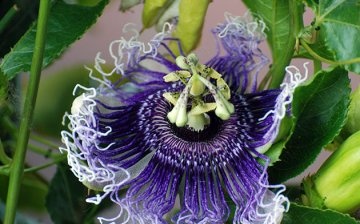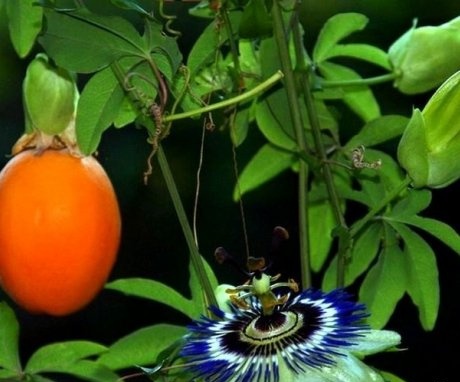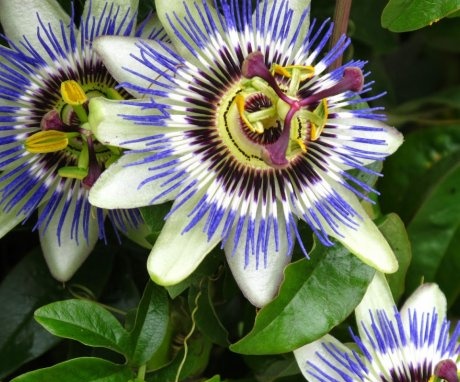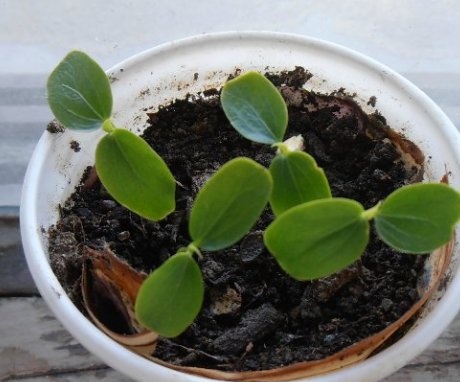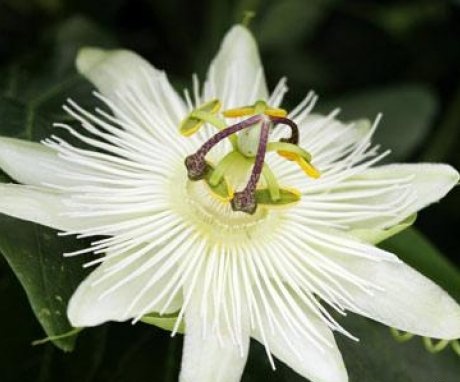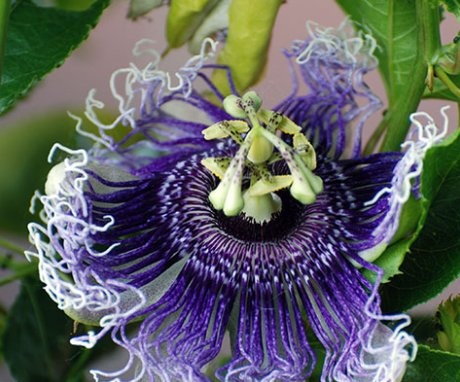Passionflower blue - exotic liana on the windowsill
Passionflower is a liana with exotic and very beautiful flowers. Growing it at home is not as difficult as it might seem at first glance.
Despite the external amazing originality and love for warm regions, blue passionflower is unpretentious and grows well in a continental climate. The accustomed passionflower will calmly survive the cold winter and will delight you with luxurious bright flowers.
Content:
- Description of the plant
- Passion flower care
- Reproduction: seeds and cuttings
- Transplant of passionflower and varieties
- Diseases and pests
Description of the plant
Passionflower blue has many names. It is popularly called the Passion Flower or the Cavalry Star. Brazil, Uruguay, Argentina, Madagascar are considered its homeland. The plant appears to be a vine, reaching a length of 9 meters. As it grows, the stem of the liana stiffens. Passionflower can self-attach and grow on vertical surfaces. Long antennae help her in this.
Passionflower blue was named the Cavalry Star because of the similarity with the order.
The flowers are quite large (about the size of the palm), bright and resemble a star from a distance. The petals are arranged in layers. First, larger and sharper petals, and then smaller and thinner ones in the center. The pistil and stamens are large, strongly projecting forward. The pistil is dark, burgundy, and the stamens are bright yellow. Unusual passionflower flowers fall off within a day after they bloom, and then more and more new buds appear.
The peculiarity of the plant is not only unusual flowers, but also the shape of the leaves. Passionflower has large leaves, up to 15 cm in diameter, dissected into separate "fingers". Each leaf has 5-7 such fingers. Passionflower blooms in spring and summer. It blooms for a long time, up to 4 months. It can be grown both at home and outdoors. However, passionflower tends to grow rapidly in length, so it soon becomes cramped at home.
When the flower has faded, a soft, edible fruit is formed. In the blue passionflower, this fruit is tasteless, however, some types of passionflower produce sweet fruits (for example, passionfruit). However, even tasteless fruits can be used as food for the valuable vitamins and minerals they contain. Usually, passionflower grown for decorative purposes. This flower cannot be called capricious, but it requires certain conditions, for example, maintaining the temperature at a certain level, which may seem too difficult for a novice gardener.
Passion flower care
Among the many varieties of this flower, passionflower blue is the most unpretentious to care for. However, like all members of the Passionaceae family, the plant grows well only under certain conditions, from which it is not recommended to deviate greatly.
All the conditions for growing passionflower are feasible, simple, but mandatory:
- A lot of light. Passionflower blue grows and color only when there is an abundance of light. Liana it is not even afraid of direct sunlight, so in spring and summer it can be taken out onto the balcony.If passionflower grows in an apartment, you need to choose the brightest place for it or provide it with artificial light. Be sure to need additional lighting in the winter, when daylight hours are reduced. For passionflower to grow and bloom well, it must be exposed to light for at least 12 hours a day.
- Heat. Despite the tropical origin of the flower, he does not like drought and heat too much. The ideal conditions for growing passionflower blue is a temperature of 20 to 26 degrees. Temperature rise above 30 degrees is undesirable. In winter, 14 degrees will be enough.
- Plenty of water. Passionflower loves moisture and good watering... In the spring and summer during the period flowering it needs to be watered especially abundantly. But balance is important. Passionflower will not tolerate both drought and waterlogging. Even in winter, when the flower stops blooming, watering is not stopped, but only reduced to maintain the growth and life of the plant. It is advisable to moisten not only the soil, but also the air in the room where the plant is located. Passionflower loves moisture, and the dry air causes flowers to fall off.
- Top dressing... Passionflower needs feeding during the flowering period. At this time, the plant is fed weekly with complex mineral fertilizers... In autumn and winter, feeding is stopped.
- Pruning... Passionflower blue must be cut off, not only because it is actively growing, but for a more luxuriant flowering... A long liana does not find enough strength for flowers. Trim passionflower it is necessary before the start of active sap flow and flowering, in early spring, leaving a third of the length of the stems. It is also not recommended to cut the passionflower too much, this can lead to the death of the plant.
Reproduction: seeds and cuttings
Passionflower blue can be propagated seedscollected from fruits, or apical cuttings... Both methods are quite effective and simple.
Passion flower cuttings:
- To propagate passionflower by cuttings, small tops with internodes are cut from the mother plant.
- The resulting cuttings are planted in a warm, humid place (greenhouse, box, etc.) or placed in a small container with water and placed in a bright place so that the cuttings give roots.
Reproduction by seeds:
- First you need to collect the seeds and prepare them for germination... Seeds are prepared using scarification. This is the process of softening the top shell of the seed so that it germinates more efficiently. To scarify passionflower seeds, first rub them lightly with sandpaper (slightly so as not to damage the core), and then soak them in citrus juice, where the shell softens under the action of acid.
- After scarification, the seeds are ready for planting. They can be planted in boxes in special soil purchased from a gardening store, or in separate peat cups.
- You can prepare a mixture for planting passionflower yourself. For this you need to mix peat, sand, humus. The prepared soil must be disinfected in order to destroy all possible parasites. It is heated in an oven at a temperature of 200 degrees.
- After the seeds already planted in the ground, pots and boxes need to be covered with plastic wrap and put in a warm place. You can not keep the film closed at all times, the seeds can rot. Every day, the film needs to be slightly opened, the seedlings should be ventilated for 5 minutes.
- As soon as the first shoots hatch, you will need to increase the lighting or put the box in a brighter place. If the seeds were planted in a large box, then you need to plant them separately after the appearance of the first two leaves.
You can increase germination with hydrogen peroxide. First you need to select the seeds. Fill them with water, remove the floating ones, and leave the rest. The remaining seeds should be placed in a glass container and filled with a small amount of 3% hydrogen peroxide.The peroxide will dissolve the shell and at the same time disinfect the seeds.
After all these procedures, the seeds are placed in a solution (100 ml of water + 50 drops of hydrogen peroxide), the jar is closed (made of transparent glass) and left for a week. The jar should be stored in a dark place and not opened for 7 days.
Transplant of passionflower and varieties
Transfer Passionflower may be required if it has already grown strongly and it is cramped in the room (or in an old pot). The transplant process does not require any special manipulations. From the softened moistened earth, gently dig out and pull out the passionflower. You also need to gently shake off excess soil from the roots. The best time for transplanting is early spring before sap flow begins. In summer, a transplant is possible, but not in extreme heat. In autumn and winter, it is undesirable to touch the flower. It is dormant, and such manipulations can lead to the death of the plant.
It is often recommended to transplant passionflower after purchase at a flower shop. Usually the pots in which the plants are sold are designed only for transportation, and instead of full-fledged soil, it contains peat. In order for the plant to take root, it needs to be transplanted and the soil in the pot changed. Such a transplant is considered forced, therefore it does not depend on the month and time of year.
Passionflower grows very quickly, so at home it can be replanted every year by changing pots and pruning shoots.
If the plant is old enough and is already in a large pot, it can be replanted as needed, and instead of replanting the topsoil can be replaced with a new one. If the passionflower has grown so much that the soil has become unusable, a complete transplant is done with the replacement of all the soil in the pot. When transplanting from the root, thoroughly shake off and remove all the soil, the plant is transplanted into a new pot without an earthen coma.
After transplants you need to take care of passionflower in a standard way. To create more gentle conditions, you can increase the temperature and humidity, creating a greenhouse effect for a while.
The most common varieties of passionflower blue are as follows:
- Constance Elliot C. This variety, although it belongs to the blue passionflower, has white flowers. The leaves are five-fingered bright green, the flowers are white, resembling snowflakes.
- Star of Mikanc. This variety has bright pink flowers and a burgundy or purple center. The flowers of this plant look so bright that they can be mistaken for artificial.
- Lavender Lady. This flower also has pink buds, but the color is softer and more delicate, with a lilac tint.
Diseases and pests
Most often, there are no special problems with passionflower blue. In most cases, passionflower blue diseases are associated with a violation of the rules of care. To improve the situation, in some cases, it is enough to establish a regime glaze and change the temperature.
Common diseases and pests of passionflower blue:
- Anthracnose. This fungal disease can affect many plants. Disease transmitted through infected the seeds or plant remains. If passionflower gets sick with anthracnose, it must be removed along with the earth. No treatment can be active against this disease. The fungus affects the entire terrestrial part of the plant. On the leaves, you can find brown spots, at first single. They grow and merge together. The same spots appear on the stems. In the affected areas of the plant, the movement of nutrients is disrupted, and it dies.
- Spider mite. The spider mite appears quickly, but it is very difficult to remove it completely. This pest will quickly spread to all neighboring plants, so you need to start the fight against it as early as possible. You can identify a spider mite by a thin web between the leaves of the plant. To get rid of a tick, you need to thoroughly and repeatedly rinse the plant with cool water, treat it with a solution of laundry soap, spray a solution of infusion of orange peels.
- Mealybug. These pests are popularly called hairy lice. They are large enough and easily recognizable at first glance. First, you can replace the insects themselves, and then the white bloom that they leave on the plant. Mealybug slows down the growth of the plant, weakens it. If there are not too many of them, you can pick up the pests by hand or remove the affected leaves and shoots. In case of severe damage, the plant can be treated with special drugswhich are absorbed into the plant and poison insects.
Passionflower begins to ache with excessive watering: his stem rots. With a lack of light and moisture, buds do not form at all, passionflower does not bloom. Most diseases can be avoided by monitoring the humidity of the air and soil. Excessive dryness leads to pests such as spider mites, and excessive moisture leads to decay of the roots and stem.
More information can be found in the video:



